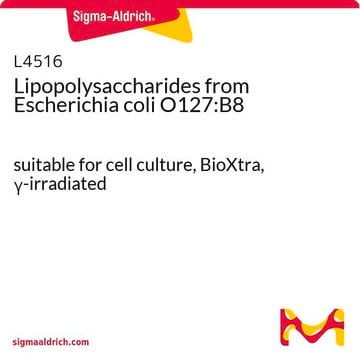L5418
Lipopolysaccharides from Escherichia coli O55:B5
Ready Made solution, 1 mg/mL
Synonyme(s) :
LPS
About This Item
Produits recommandés
Source biologique
Escherichia coli (O55:B5)
Niveau de qualité
Forme
aqueous solution
Concentration
1 mg/mL
Couleur
white to faint yellow
Solubilité
water: 4.90-5.10 mg/mL, faintly hazy to hazy, colorless to faintly yellow
Conditions d'expédition
wet ice
Température de stockage
2-8°C
Vous recherchez des produits similaires ? Visite Guide de comparaison des produits
Description générale
Application
Actions biochimiques/physiologiques
Notes préparatoires
Autres remarques
Produit(s) apparenté(s)
Code de la classe de stockage
12 - Non Combustible Liquids
Classe de danger pour l'eau (WGK)
WGK 1
Point d'éclair (°F)
Not applicable
Point d'éclair (°C)
Not applicable
Équipement de protection individuelle
Eyeshields, Gloves, multi-purpose combination respirator cartridge (US)
Certificats d'analyse (COA)
Recherchez un Certificats d'analyse (COA) en saisissant le numéro de lot du produit. Les numéros de lot figurent sur l'étiquette du produit après les mots "Lot" ou "Batch".
Déjà en possession de ce produit ?
Retrouvez la documentation relative aux produits que vous avez récemment achetés dans la Bibliothèque de documents.
Les clients ont également consulté
Notre équipe de scientifiques dispose d'une expérience dans tous les secteurs de la recherche, notamment en sciences de la vie, science des matériaux, synthèse chimique, chromatographie, analyse et dans de nombreux autres domaines..
Contacter notre Service technique



